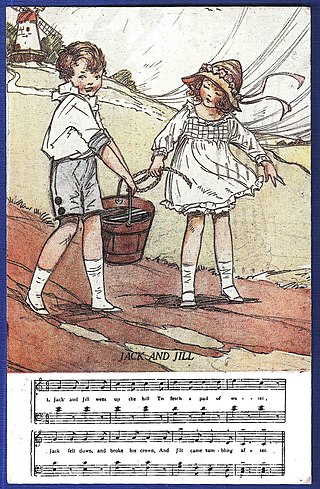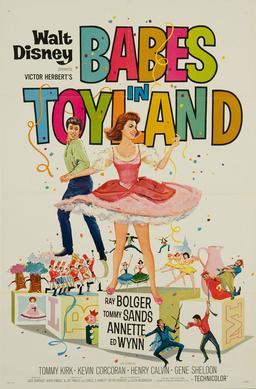
A nursery rhyme is a traditional poem or song for children in Britain and many other countries, but usage of the term dates only from the late 18th/early 19th century. The term Mother Goose rhymes is interchangeable with nursery rhymes.

"Jack and Jill" is a traditional English nursery rhyme. The Roud Folk Song Index classifies the commonest tune and its variations as number 10266, although it has been set to several others. The original rhyme dates back to the 18th century and different numbers of verses were later added, each with variations in the wording. Throughout the 19th century new versions of the story were written featuring different incidents. A number of theories continue to be advanced to explain the rhyme's historical origin.

"Old Mother Hubbard" is an English-language nursery rhyme, first given an extended printing in 1805, although the exact origin of the rhyme is disputed. It has a Roud Folk Song Index number of 19334. After a notable nursery success, it was eventually adapted to a large variety of practical and entertaining uses.

"Little Jack Horner" is a popular English nursery rhyme with the Roud Folk Song Index number 13027. First mentioned in the 18th century, it was early associated with acts of opportunism, particularly in politics. Moralists also rewrote and expanded the poem so as to counter its celebration of greediness. The name of Jack Horner also came to be applied to a completely different and older poem on a folkloric theme; and in the 19th century, it was claimed that the rhyme was originally composed in satirical reference to the dishonest actions of Thomas Horner in the Tudor period.

The Bishop Murder Case (1929) is the fourth in a series of mystery novels by S. S. Van Dine about fictional detective Philo Vance. The detective solves a mystery built around a nursery rhyme. The Bishop Murder Case is believed to be the first nursery-rhyme mystery book.

The Librarian: Quest for the Spear is a 2004 American made-for-television fantasy-adventure film and the first in the Librarian franchise of movies. It was originally released on American cable channel TNT on December 5, 2004, written by David Titcher, directed by Peter Winther and starring Noah Wyle.

Babes in Toyland is a 1961 American Christmas musical film directed by Jack Donohue and produced by Walt Disney Productions. It stars Ray Bolger as Barnaby, Tommy Sands as Tom Piper, Annette Funicello as Mary Contrary, and Ed Wynn as the Toymaker.

The Big Over Easy is a 2005 novel written by Jasper Fforde. It features Detective Inspector Jack Spratt and his assistant, Sergeant Mary Mary.

Roberta Williams' Mixed-Up Mother Goose is a computer game first released by Sierra On-Line in 1987. It is, in essence, an edutainment title, directed specifically at young gamers, as well as an adventure game. It was the first multimedia game released on CD-ROM in 1991. A second game in the series, Mixed-Up Fairy Tales, was released in 1991.

"There was an Old Woman Who Lived in a Shoe" is a popular English language nursery rhyme, with a Roud Folk Song Index number of 19132. Debates over its meaning and origin have largely centered on attempts to match the old woman with historical female figures who have had large families, although King George II (1683–1760) has also been proposed as the rhyme's subject.
Mother Goose Rock 'n' Rhyme is a 1990 American musical television film that aired on the Disney Channel. The film stars Shelley Duvall as Little Bo Peep and Dan Gilroy as Gordon Goose, the son of Mother Goose, along with a star-studded supporting cast of actors and musicians portraying a wide range of characters, mostly of Mother Goose nursery rhyme fame.

Mother Goose Goes Hollywood is a 1938 animated short film produced by Walt Disney Productions and distributed by RKO Radio Pictures. The short was released on December 23, 1938. The film parodies several Mother Goose nursery rhymes using caricatures of popular Hollywood film stars of the 1930s. The film was directed by Wilfred Jackson and was the third-to-last Silly Symphony produced.

Mots D'Heures: Gousses, Rames: The D'Antin Manuscript, published in 1967 by Luis d'Antin van Rooten, is purportedly a collection of poems written in archaic French with learned glosses. In fact, they are English-language nursery rhymes written homophonically as a nonsensical French text ; that is, as an English-to-French homophonic translation. The result is not merely the English nursery rhyme but that nursery rhyme as it would sound if spoken in English by someone with a strong French accent. Even the manuscript's title, when spoken aloud, sounds like "Mother Goose Rhymes" with a strong French accent; it literally means "Words of Hours: Pods, Paddles."

The Oldest Profession is a 1967 internationally co-produced comedy film. It features contributions from six different film directors, each one doing a segment on prostitution through the ages.
Rub-A-Dub-Dub was a British television series animated by Peter Lang and Alan Rogers of the Cut-Out Animation Co. They were previously famous for Pigeon Street. The series was produced by David Yates and Joe Wolf. The title is a reference to the nursery rhyme Rub-a-dub-dub. Rub-A-Dub-Dub was animated in a similar way, yet all the characters were anthropomorphic animals. It ran in 1984, completing 25 episodes.
The Truth About Mother Goose is an animated film released on August 28, 1957, by Walt Disney Productions. The short was directed by Wolfgang Reitherman in his directorial debut, and Bill Justice, and written by Bill Peet.

The Falcon in Hollywood is a 1944 crime film directed by Gordon Douglas and stars Tom Conway in his recurring role as a suave amateur sleuth, supported by Barbara Hale, Jean Brooks, and Rita Corday. The film was the 10th of 16 in Falcon detective series.

The Well Groomed Bride is a 1946 American romantic comedy film directed by Sidney Lanfield and starring Olivia de Havilland, Ray Milland, and Sonny Tufts. Written by Claude Binyon and Robert Russell, the film is about a man and a woman who fight over the last bottle of champagne left in San Francisco—he wants it to christen a new aircraft carrier, and she wants it as the centerpiece for her upcoming wedding reception. During the course of their fierce battle over the bottle, the two fall in love. This was de Havilland's first film after a two-year legal battle she waged against Warner Bros. regarding her rights under her contract.
A Gander at Mother Goose is a 1940 Warner Bros. Merrie Melodies cartoon directed by Tex Avery and written by Dave Monahan. The short was released on May 25, 1940.

"Hark, Hark! The Dogs Do Bark" is an English nursery rhyme. Its origins are uncertain and researchers have attributed it to various dates ranging from the late 11th century to the early 18th century. The earliest known printings of the rhyme are from the late 18th century, but a related rhyme was written down a century earlier than that.
















